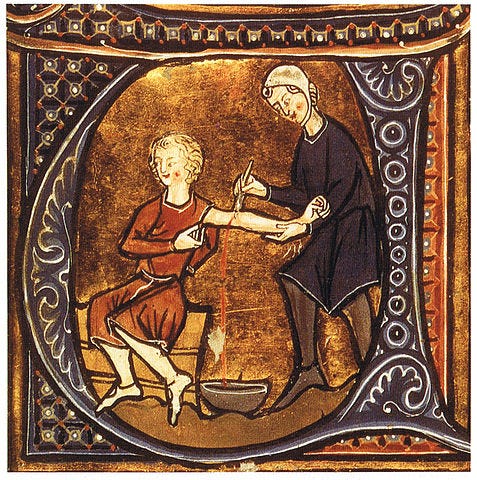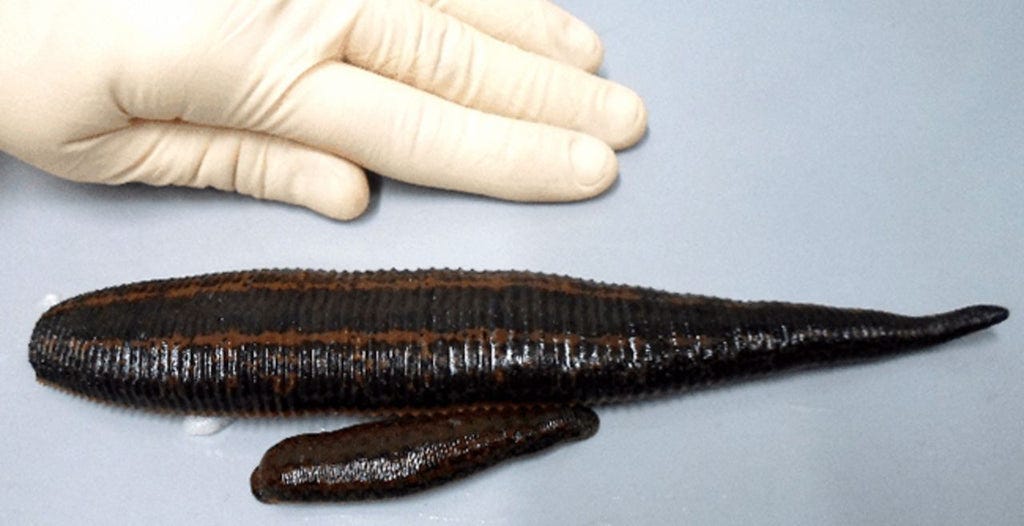You need to bleed
It's a stone cold, no-brainer for middle aged men to donate blood regularly
Too much iron is bad, it’s a pro-oxidant. Extra iron bangs around your body damaging DNA and doing things like oxidizing LDL.
Reasons you might have too much iron
You have hemochromatosis—~6% of Americans are carriers for hemochromatosis. In general those of northern European descent are more likely to carry the mutation that causes hemochromatosis than descendants of southern Europeans. The gene is most common in Ireland, where more that 12% of the population is a carrier—which is why hemochromatosis is also known as the Celtic Curse. If you only have one copy of the gene that causes hemochromatosis it’s very unlikely you will have acute symptoms, but your iron may be higher than optimal—Pathophysiological consequences and benefits of HFE mutations: 20 years of research
You have liver dysfunction from alcoholic liver disease, nonalcoholic fatty liver disease, or hepatitis C viral infection which reduces the production of hepcidin—The Role of Iron and Iron Overload in Chronic Liver Disease
You don’t exercise or bleed enough. A examination of the participants in the Framingham Heart Study found that 13% of participants had elevated iron stores, only 1% of which was attributable to hereditary factors or chronic disease—Iron status of the free-living, elderly Framingham Heart Study cohort: an iron-replete population with a high prevalence of elevated iron stores and Dysmetabolic Hyperferritinemia: All Iron Overload Is Not Hemochromatosis1
Even if you’re negative for hereditary hemochromatosis, you can still have iron overload. Determine this by asking your doctor for a ferritin test. According to the Mayo Clinic, for men, the ferritin reference range is 24 to 336 ng/ml, and for women, it is 11 to 307. That is a wide range, and levels that your doctor would probably classify as technically normal have been associated with insulin resistance, atherosclerosis, and reduced telomere length (a marker of aging).
From what I can tell, levels approaching 200 ng/ml in men should definitely be classified as “high.” And lower may be even better. In one study, egg-and-dairy-eating vegetarian men had ferritin levels of 35 ng/ml and better insulin sensitivity than meat-eating men with ferritin levels of 72 ng/ml. After donating enough blood to hit 35 ng/ml, the meat eaters insulin sensitivity improved.
Bleed me: why excess iron can be dangerous
Iron is a most versatile element. It is essential to many of the enzymes that are the engines for life, and in mammals is also used to carry oxygen on hemoglobin in blood. Remember Popeye and his spinach: all that iron made him strong.
But the very quality that makes iron so useful also makes it dangerous. Iron can easily lose or gain one electron going from the ferrous (Fe++) to the ferric (Fe+++) state, back and forth indefinitely. This is how it carries oxygen, for example.
It also means it can be a potent pro-oxidant – it catalyzes the production of free radicals which can destroy cells and tissue, and thereby contribute to cancer and heart disease.
The Benefits of Blood Donation
No heart attacks
88% Reduced Risk of Heart Attack
A cohort of 2,862 men aged 42-60 years were followed for an average of almost 9 years. One man (0.7%) out of 153 men who had donated blood in 24 months preceding the baseline examination experienced an acute myocardial infarction during 1984 to 1995, whereas 316 men (12.5%) of 2,529 non-blood donors had an acute myocardial infarction (p < 0.0001 for difference between proportions). In a Cox proportional hazards model adjusting for age, examination years and all other predictive coronary disease risk factors, blood donors had a 88% reduced risk (relative hazard = 0.12, 95% confidence interval 0.02-0.86, p = 0.035) of acute myocardial infarction, compared with non-blood donors.
Although this study tries to adjust risk factors to isolate the effect of blood donation, there is the possibility that it is just reflecting the Healthy Donor Effect—Associations of health status with subsequent blood donor behavior—An alternative perspective on the Healthy Donor Effect from Donor InSight.
But this study which makes further adjustments for the Healthy Donor Effect still shows a substantial inverse relationship between blood donation and mortality.
Blood donation and blood donor mortality after adjustment for a healthy donor effect
Analyses adjusted only for demographic characteristics showed a 18.6% reduction in mortality per additional annual donation (95% confidence interval [CI], 16.8%-20.4%). After additional adjustment for the internal healthy donor effect, each additional annual donation was associated with a 7.5% decreased mortality risk 7.5% (95% CI, 5.7%-9.4%).
Lowers Blood Pressure
There was a clear dose effect with decreasing BP by the increasing number of blood donations. After at least four blood donations, donors with Stage II hypertensive baseline values (≥ 160 mmHg SBP and/or ≥ 100 mmHg DBP) were found to have the most marked reduction in BP, with 17.1 mmHg (95% confidence interval [CI], -23.2 to -11.0; p < 0.0001) and 11.7 mmHg (95% CI, -17.1 to -6.1; p = 0.0006) for SBP and DBP, respectively.
Less Cancer
Body iron stores and the risk of cancer
These results are consistent with the hypothesis that high body iron stores increase the risk of cancer in men. The possibility that a similar association exists in women requires further study.
Risk of new visceral malignancy was lower in the iron reduction group than in the control group (38 vs 60, hazard ratio [HR] = 0.65, 95% CI = 0.43 to 0.97; P = .036), and, among patients with new cancers, those in the iron reduction group had lower cancer-specific and all-cause mortality (HR = 0.39, 95% CI = 0.21 to 0.72; P = .003; and HR = 0.49, 95% CI = 0.29 to 0.83; P = .009, respectively) than those in the control group. Mean ferritin levels across all 6-monthly visits were similar in patients in the iron reduction and control groups who developed cancer but were lower among all patients who did not develop cancer than among those who did (76.4 ng/mL, 95% CI = 71.4 to 81.4 ng/mL, vs 127.1 ng/mL, 95% CI = 71.2 to 183.0 ng/mL; P = .017).
Healthier Mitochondria
Mitochondrial DNA Damage in Iron Overload
The present investigations were focused on the etiology of iron-mediated cardiac damage and specifically on the question of why, in patients with chronic iron overload, damage to organs such as the heart develops over a period of years, whereas most types of iron-mediated oxidation events can be repaired within minutes or hours. We have investigated the hypothesis that cumulative damage to DNA, specifically mtDNA, is critical to the slow development of cardiac dysfunction in chronic iron overload. In partial support of this idea, earlier studies clearly show that iron does promote DNA base oxidation as well as single and double strand DNA breaks. Mitochondrial DNA may be particularly vulnerable to such oxidation events inasmuch as it lacks histones, has less effective repair systems and, perhaps most importantly, resides within an organelle that ceaselessly generates ROS.
Less Diabetes
In patients with METS, phlebotomy, with consecutive reduction of body iron stores, lowered BP and resulted in improvements in markers of cardiovascular risk and glycemic control. Blood donation may have beneficial effects for blood donors with METS.
Iron stores, blood donation, and insulin sensitivity and secretion
Blood donation is simultaneously associated with increased insulin sensitivity and decreased iron stores. Stored iron seems to impact negatively on insulin action even in healthy people, and not just in classic pathologic conditions associated with iron overload (hemochromatosis and hemosiderosis). According to these observations, it is imperative that a definition of excessive iron stores in healthy people be formulated.
Less ‘forever chemicals’ in your body
Plasma and blood donations caused greater reductions in serum PFAS levels than observation alone over a 12-month period
Improves sleep quality for elderly mice
In the present study, we discovered the consistent changes of six clock genes in the liver of old and iron-overload mice. All these suggest that iron accumulation may be a driving factor in inducing circadian and sleep disturbances in the old.
Cures Gout
Near-iron deficiency-induced remission of gouty arthritis
Quantitative phlebotomy was used to remove iron in 12 hyperuricaemic patients with gouty arthritis and maintain their body iron at near-iron deficiency (NID) level (i.e. the lowest body iron store compatible with normal erythropoiesis and therefore absence of anaemia). During maintenance of NID for 28 months, gouty attacks markedly diminished in every patient, from a cumulative amount of 48 and 53 attacks per year before (year -2, -1), to 32, 11 and 7 during induction (year 0) and maintenance (year +1, +2) of NID, respectively. During NID, attacks were also more often of milder severity.
Bloodletting was common for 3000 years.
Longevity of a practice isn’t dispositive evidence that something is rational and/or beneficial. But its certainly suggestive that blood letting is beneficial, if only as a placebo.
In the days when doctors had little in the way of effective treatment, and there was a need to be seen to be doing something to treat the patient, the placebo effect of bloodletting should not be underestimated. This is probably also true for other practices long discarded by mainstream Western medicine, such as blisters and purging. However, when such an astute clinical observer as William Osler believed that venesection was helpful in some patients it would perhaps be unwise to assume the reputed benefits were simply the result of a placebo effect
If you don’t want to donate blood, the folks at medicalleeches.com can hook you up
The giant pet leeches can be fed every 3 to 6 months on your house pet or on your own self, such as on your arm or back of the neck. These leeches will expand to quite a Huge size when fed and full of blood.
If you purchase two pet leeches of this giant size and you keep them together, they will eventually mate in spring and one might become pregnant and give birth to a leech cocoon full of baby leeches.
Don’t be like the guy that doesn’t use Castrol GTX, protect yourself against viscosity and thermal breakdown by donating blood
The normal total body iron content of 3-4 g is the result of a tight balance between iron absorbed from the gastrointestinal tract and iron lost in stool, sweat and via shed skin cells. If the iron supply or gastrointestinal tract absorption of dietary iron exceeds the amount needed, there is no mechanism to eliminate the excessive iron. This state of presence of iron in excess of what is needed is called iron overload.



